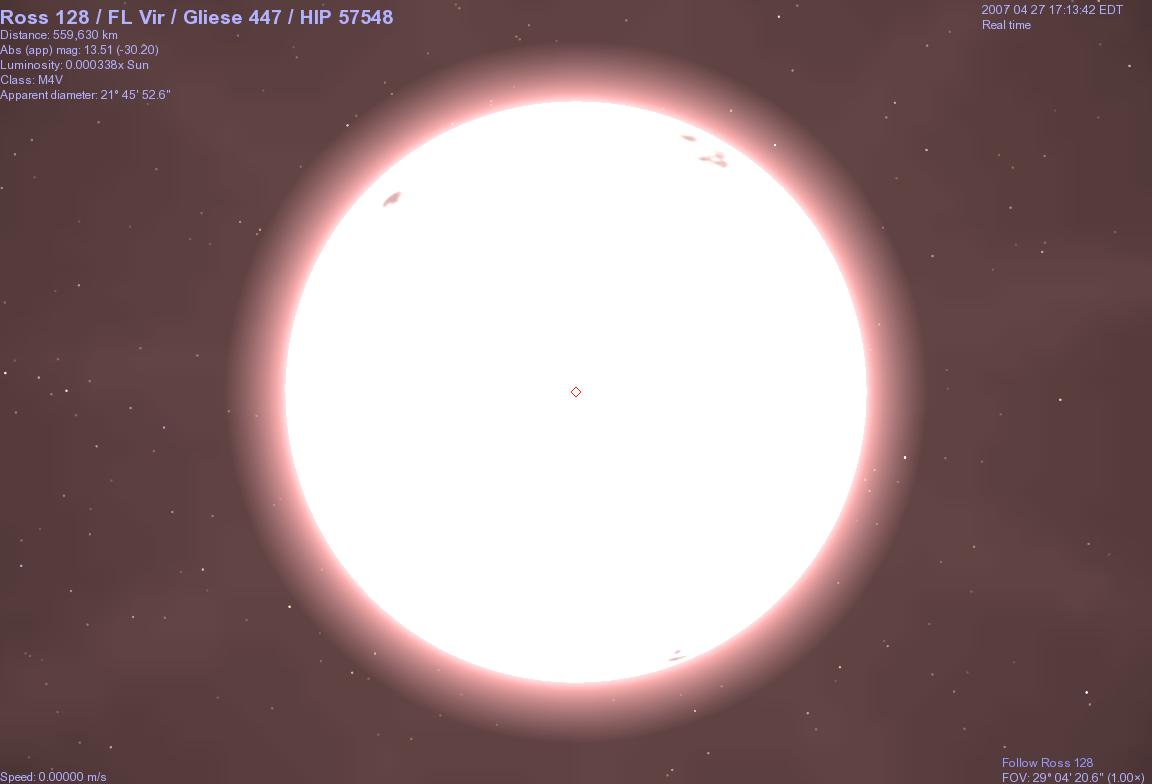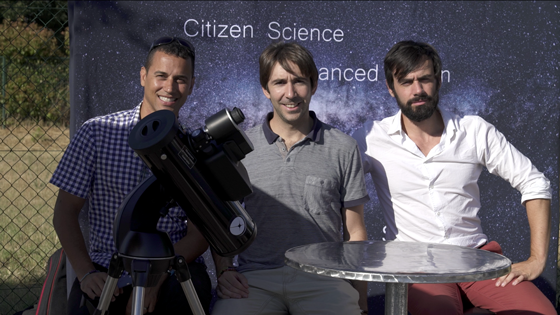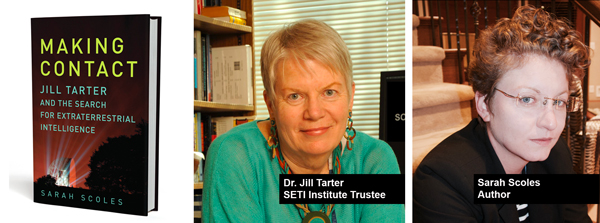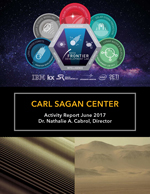
The 40th anniversary of the Voyager Golden Record takes place in August. Voyager 1 and Voyager 2 are space probes launched in 1977. The original mission to explore Jupiter, Saturn, Uranus and Neptune has been extended three times, and both probes are now exploring interstellar space, sending data and images back to Earth and expanding understanding of the Universe. Each probe carries a copy of the Golden Record, which includes sounds and images that portray the diversity of life and culture on Earth. Frank Drake, who conducted the first-ever SETI experiment and is Chairman Emeritus of the SETI Institute Board of Trustees, was a member of the committee that determined what to include on the Golden Record. Another member of the committee was Carl Sagan.
- Irish Examiner: The Night Sky is a Long Way from Tipperary
- Boing Boing: Experience the Voyager Golden Record at San Francisco Exploratorium
- SETI.org: Are the Aliens Already Chuck Berry Fans?
 Ross 128 – No Aliens Detected, Yet
Ross 128 – No Aliens Detected, YetRoss 128, a red dwarf star, caused a lot of excitement back in May. The mystery has now been solved, indicating that strange signals detected at the Arecibo telescope were likely due to transmissions from Earth satellites. The SETI Institute’s Allen Telescope Array (ATA) observed Ross 128 for 16 hours and detected no evidence for a signal originating from the star system. The Greenbank Telescope and Arecibo also conducted additional observations.
- SETI.org: Signals from a Nearby Star System? (Update)
- Futurism: Source of Weird! Signal from Nearby Star Finally Confirmed
- SciNews: ‘Weird!’ Signal from Ross 128 isn’t from Extraterrestrial Intelligence, Astronomers Say
- Pulse: Astronomers Say Weird Radio Signals Coming from Ross 128 are not Alien Transmissions
- New Atlas: ET Not Responsible for Mystery Stellar Radio Signals After All
- Fox News: Not Aliens: Weird Radio Signal from Star Likely has Duller Explanation
- Fox Weekly: Mysterious Space Signal!
- Free NewsMan: Astronomers Detect Signals from the Red Dwarf Star
 SETI Institute-Unistellar Partnership on Networked eVsope
SETI Institute-Unistellar Partnership on Networked eVsopeThe SETI Institute and French startup Unistellar announced a partnership to commercialize a new telescope. This new type of telescope that delivers an image not previously available to amateur astronomers, that can identify the object they are observing, and that enables them to participate in observing campaigns and share the data with researchers.
- SETI.org: SETI Institute-Unistellar Promises to Revolutionize Amateur Astronomy
- Green Area: Networked eVscope Would Crowd-Source Amateur Astronomy
 Making Contact: A Book About Jill Tarter’s Life and Work by Sarah Scoles
Making Contact: A Book About Jill Tarter’s Life and Work by Sarah ScolesMaking Contact, a book written by Sarah Scoles about the life and work of the SETI Institute’s Jill Tarter was released on July 4. Jill is one of the founders of the SETI Institute and currently holds the Bernard M. Oliver Chair at the SETI Institute. One the biggest challenges faced by Jill, other SETI researchers and the SETI Institute has been in trying to get SETI research funded, a challenge that is ongoing.
- SETI.org: The Biography of SETI Pioneer Jill Tarter, Making Contact: Jill Tarter and the Search for Extraterrestrial Intelligence is Released
- The Wall Street Journal: Summer Books for your Inner Nerd
- Science News: ‘Making Contact’ Chronicles an Astronomer’s Struggle to Find E.T.
- Fox 31 Denver: Search for Extraterrestrial Intelligence Brings SETI to Denver
In last week’s Facebook Live, SETI Institute President and CEO Bill Diamond talked two teams from this summer’s NASA Frontier Development Lab (FDL) which is hosted by the SETI Institute. The two teams were Radar 3D Shape Modeling and Long Period Comets.
All SETI Institute Facebook Live videos can be found on our Facebook page.
 Big Picture Science
Big Picture ScienceLast week, What Goes Around explored recycling and more. This week, the encore presentation of Caught in a Traps talks earthquakes, volcanoes and more.
- California Academy of Sciences Astronomy Lectures: September 11, San Francisco, CA Matt Tiscareno will about the end of the Cassini mission and the science of its grand finale.
- StarTalk Radio, September 16-17, Seth Shostak will guest host this Neil deGrasse Tyson radio program that explores science, pop culture and comedy.
The Carl Sagan Center Activity Report for June 2017 is out and can be downloaded here. Here are some highlights:
- Dale Andersen co-authored a paper that has been accepted for publication in the Journal of Microbiological Methods, ‘Comparison of two bioinformatics tools used to characterize the microbial diversity and predictive functional attributes of microbial mats from Lake Obersee, Antarctica’
- Susan Thompson was lead author of the catalog study for the Kepler survey mission
- SETI Institute scientists participated in conferences and events including the 4th Kepler/K2 Science Conference; the 3rd Planetary Data Workshop; Starmus Festival IV: Life and the Universe; and the AAS Division on Dynamical Astronomy Meeting
- Facebook Live events featured Kathryn Bywaters, Margaret Race, Susan Thompson, and Jeff Coughlin
- Lori Fenton curated the geoscience Twitter account @GeoSciTweeps for the week of June 26-July2
- Seth Shostak was interviewed by numerous print and broadcast news outlets including NBC News, KGO Radio San Francisco, Science Fantastic, and KQED
- Matt Tiscareno has been participating in the production of numerous documentaries about Cassini
- Jill Tarter, Jon Richards and Gerry Harp to participants of the Machine Learning for SETI hackathon held June 10-11






